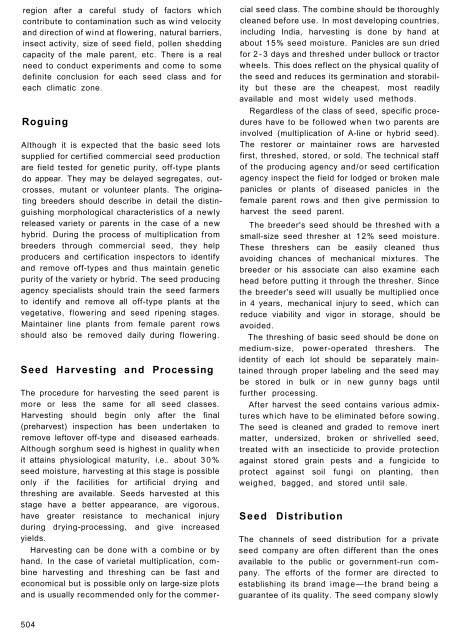RA 00048.pdf - OAR@ICRISAT
RA 00048.pdf - OAR@ICRISAT
RA 00048.pdf - OAR@ICRISAT
You also want an ePaper? Increase the reach of your titles
YUMPU automatically turns print PDFs into web optimized ePapers that Google loves.
egion after a careful study of factors which<br />
contribute to contamination such as wind velocity<br />
and direction of wind at flowering, natural barriers,<br />
insect activity, size of seed field, pollen shedding<br />
capacity of the male parent, etc. There is a real<br />
need to conduct experiments and come to some<br />
definite conclusion for each seed class and for<br />
each climatic zone.<br />
Roguing<br />
Although it is expected that the basic seed lots<br />
supplied for certified commercial seed production<br />
are field tested for genetic purity, off-type plants<br />
do appear. They may be delayed segregates, outcrosses,<br />
mutant or volunteer plants. The originating<br />
breeders should describe in detail the distinguishing<br />
morphological characteristics of a newly<br />
released variety or parents in the case of a new<br />
hybrid. During the process of multiplication from<br />
breeders through commercial seed, they help<br />
producers and certification inspectors to identify<br />
and remove off-types and thus maintain genetic<br />
purity of the variety or hybrid. The seed producing<br />
agency specialists should train the seed farmers<br />
to identify and remove all off-type plants at the<br />
vegetative, flowering and seed ripening stages.<br />
Maintainer line plants from female parent rows<br />
should also be removed daily during flowering.<br />
Seed Harvesting and Processing<br />
The procedure for harvesting the seed parent is<br />
more or less the same for all seed classes.<br />
Harvesting should begin only after the final<br />
(preharvest) inspection has been undertaken to<br />
remove leftover off-type and diseased earheads.<br />
Although sorghum seed is highest in quality when<br />
it attains physiological maturity, i.e.. about 3 0 %<br />
seed moisture, harvesting at this stage is possible<br />
only if the facilities for artificial drying and<br />
threshing are available. Seeds harvested at this<br />
stage have a better appearance, are vigorous,<br />
have greater resistance to mechanical injury<br />
during drying-processing, and give increased<br />
yields.<br />
Harvesting can be done with a combine or by<br />
hand. In the case of varietal multiplication, combine<br />
harvesting and threshing can be fast and<br />
economical but is possible only on large-size plots<br />
and is usually recommended only for the commercial<br />
seed class. The combine should be thoroughly<br />
cleaned before use. In most developing countries,<br />
including India, harvesting is done by hand at<br />
about 15% seed moisture. Panicles are sun dried<br />
for 2 - 3 days and threshed under bullock or tractor<br />
wheels. This does reflect on the physical quality of<br />
the seed and reduces its germination and storability<br />
but these are the cheapest, most readily<br />
available and most widely used methods.<br />
Regardless of the class of seed, specific procedures<br />
have to be followed when two parents are<br />
involved (multiplication of A-line or hybrid seed).<br />
The restorer or maintainer rows are harvested<br />
first, threshed, stored, or sold. The technical staff<br />
of the producing agency and/or seed certification<br />
agency inspect the field for lodged or broken male<br />
panicles or plants of diseased panicles in the<br />
female parent rows and then give permission to<br />
harvest the seed parent.<br />
The breeder's seed should be threshed with a<br />
small-size seed thresher at 12% seed moisture.<br />
These threshers can be easily cleaned thus<br />
avoiding chances of mechanical mixtures. The<br />
breeder or his associate can also examine each<br />
head before putting it through the thresher. Since<br />
the breeder's seed will usually be multiplied once<br />
in 4 years, mechanical injury to seed, which can<br />
reduce viability and vigor in storage, should be<br />
avoided.<br />
The threshing of basic seed should be done on<br />
medium-size, power-operated threshers. The<br />
identity of each lot should be separately maintained<br />
through proper labeling and the seed may<br />
be stored in bulk or in new gunny bags until<br />
further processing.<br />
After harvest the seed contains various admixtures<br />
which have to be eliminated before sowing.<br />
The seed is cleaned and graded to remove inert<br />
matter, undersized, broken or shrivelled seed,<br />
treated with an insecticide to provide protection<br />
against stored grain pests and a fungicide to<br />
protect against soil fungi on planting, then<br />
weighed, bagged, and stored until sale.<br />
Seed Distribution<br />
The channels of seed distribution for a private<br />
seed company are often different than the ones<br />
available to the public or government-run company.<br />
The efforts of the former are directed to<br />
establishing its brand image—the brand being a<br />
guarantee of its quality. The seed company slowly<br />
504

















